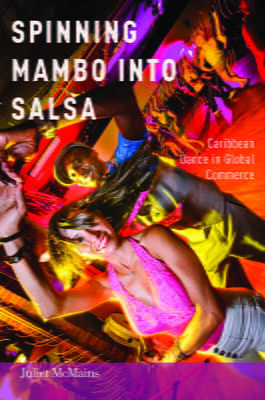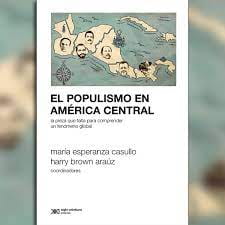A Review of Spinning Mambo into Salsa: Caribbean Dance in Global Commerce
Dancing Identity
by Manuela Azuaje-Alamo

Spinning Mambo into Salsa: Caribbean Dance in Global Commerce, by Juliet McMains (Oxford University Press, 2015)
At a fancy yet packed bar in Tokyo’s most cosmopolitan district; at the patio of a bar in Vancouver facing the Canadian Rockies; at a hotel lounge bar overlooking the skyline of Shanghai’s Bundt; at another bar, this one within walking distance of New York’s Central Park; at a bar hidden a couple of blocks away from Istanbul’s Taksim Square, overlooking the Bosphorus Strait which divides the European and Asian continents—these are some of the places where I have danced salsa, definitely one of the most prominent cultural exports from Latin America in today’s globalized world. In fact, during my more than 10 years of living in Asia, salsa has been the most reliable way for me to keep in contact with my Latin American roots. Even at this very moment, as I write these lines at a Taiwan café, the songs coming out of the ceiling speakers form a constant loop of Latin rhythms and remixes, yet I probably am the only person in the whole establishment who understands their Spanish lyrics.
The role of salsa in helping build a Latin American—or Hispanic, or even Chicano— identity within the United States has been the subject of past studies. These works overwhelmingly argued for, or recognized, the unifying strength of the Spanish language—the common tongue shared by immigrants hailing from all types of Caribbean, Central and South American cultures and environments living within the (North) American melting pot— as a key for salsa’s success as both a community and identity strengthener amongst Latin American immigrants and their descendants. Other writers emphasized the divisive aspect of salsa, with many countries in the Caribbean claiming that it was their country that gave birth to the genre, or that most helped in its development and diffusion, and each claiming that their way of dancing salsa is the most authentic, or the best, or la que tiene más sabor.
However, Juliet McMains’ book—while recognizing the importance of both perspectives in understanding the phenomenon of salsa—treads new ground in focusing principally on the way that salsa dancing has spread to all four corners of the world. It is a deeply engaging cultural history of salsa that ranges from New York to Los Angeles, from Miami to Havana, from Europe to Asia. In a confident style that is both rewarding and illuminating, the book traces the development of the dance from its multiple forefathers starting in the early decades of the 20th century—rumba, cha cha, tumbao, Cuban son, and mambo. At the same time, as the subtitle of the book implies, it never loses sight of the relationship between salsa’s history and its current status as a world-famous dance. In doing so it raises a deeply interesting issue: how should we view the commercialization of salsa as a commodity in the global market?
The Irish poet William Butler Yeats famously finished one of his poems with the line “How can we know the dancer from the dance?,” an evocative poetic image which deftly expresses the melodious blending of performance and identity at the moment of dancing. And yet, what happens when the dancer is a global consumer, vastly distant from the origins, the language, and the history of the dance? That is, whose dance is it anyway?
Juliet McMains is in an excellent position to shed some light on both: on the one hand, the history of salsa’s development, and, on the other, the politics of identity and strategies involved in its world-wide commercialization. Currently an Associate Professor of Dance at the University of Washington, she not only graduated with a B.A. in Women’s Studies from Harvard University before obtaining a Ph.D. in Dance History and Theory from the University of California at Riverside, but she also has a rigorous background as a dancer in many styles (ballroom dance, salsa, ballet, jazz) and has been a DanceSport competitor, twice named a U.S. National Rising Star.
The book benefits immensely both from McMains’ training in cultural anthropology, music and dance theory, and from her background as a dance performer and competitor. For the initial chapters of the book, in which she searches for the roots of modern salsa, she not only sought out and interviewed the few remaining dancers who frequented the birthplace of modern salsa, the legendary New York dance club The Palladium; she also danced with them and got them to share invaluable information on the development of salsa’s different styles.
Thus, McMains’ double background as both a cultural anthropologist and a professional dancer grants the book a unique double approach to its subject. At one moment in the early chapters she surprises us by unveiling the unexpected role of the New York Jewish community and its dancers in the development of salsa. At another moment a few pages later she visits a salsa night at a community center frequented by septuagenarian and octogenarian salsa dancers who were present at the early days of the dance, and is able to pinpoint, with a professional dancer’s eye, what is unique to their style. In this way, the book’s eight chapters develop in an organic manner: the history of the mambo craze in the United States gives way to the New York dancers who developed the dance in racially integrated nightclubs in which white, black, Jewish and Hispanic patrons all mingled and danced with each other. This is followed by the history of the split of salsa dancing into on-1 and on-2 dance styles, which flows into a chapter on the later development of the style know as Cuban salsa, or Salsa de Casino. The last chapters deal with the emergence of international salsa congresses in the last years of the 20th century as a defining factor in the global standardization of salsa into teachable and modifiable styles the world over. These chapters have all answered questions that I have had for years as a Latin American dancer living abroad: how are the styles different?, where did they develop?, which one is more “authentic”?
One theme which McMains might have mentioned is the other Latin America dances that have also traveled the world thanks to globalization, and especially the Latin American dances that—in a symbiotic relationship with salsa—have travelled the globe in its company: merengue, bachata, and, increasingly, kizumba. I have visited many salsa clubs around the world where these rhythms are interspersed between salsa tunes.
Bachata in particular—a dance that is slower than salsa and danced in a much more intimate and close stance—has enjoyed an international boom in the first decade of the 21st century that has been parallel to the internationalization of salsa. This is remarkable, considering that bachata was a much relegated musical genre in its native Dominican Republic until the 1980s. Similarly, the appearance of kizumba in salsa-playing clubs—a dance that originated in Angola, was further developed in France, and is mostly sung in Portuguese or French— is an interesting phenomenon of cross-cultural exchange: a Latin dance by way of the colonial Portuguese African experience intermingled with other Latin dances that originated in the colonial Spanish American experience. Nowadays, these Latin musical genres all play out in the international dance halls of salsa. Indeed, in Asia I have found dancers whose bachata or kizumba is better than their salsa, even as the dance clubs that they patronize mainly feature salsa.
That being said, this excellent history of the development of salsa and the beginning of its international boom is a great success, which is precisely the reason why I hope to one day read a similarly deep analysis of salsa’s companion dances in the global stage. For now, McMains’ excellent effort is a leap forward in our understanding of how dancers from all over the world came to dance salsa and the networks that have formed to support this international dancing culture. If you are interested in the globalization of Latin American culture, Latin American identity, or have ever tried to pick up the beat of a salsa songs as you shuffle your feet, you should definitely pick up a copy of Spinning Mambo into Salsa.
Manuel Azuaje-Alamo holds an M. A. from the University of Tokyo and from Harvard University. He is currently a Ph.D. candidate at the Department of Comparative Literature of Harvard University, and is writing his dissertation while living in Seoul, South Korea.
Related Articles
A Review of Born in Blood and Fire
The fourth edition of Born in Blood and Fire is a concise yet comprehensive account of the intriguing history of Latin America and will be followed this year by a fifth edition.
A Review of El populismo en América Latina. La pieza que falta para comprender un fenómeno global
In 1946, during a campaign event in Argentina, then-candidate for president Juan Domingo Perón formulated a slogan, “Braden or Perón,” with which he could effectively discredit his opponents and position himself as a defender of national dignity against a foreign power.
A Review of Aaron Copland in Latin America: Music and Cultural Politics
In Aaron Copland in Latin America: Music and Cultural Politics, Carol Hess provides a nuanced exploration of the Brooklyn-born composer and conductor Aaron Copland (1900–1990), who served as a cultural diplomat in Latin America during multiple tours.




